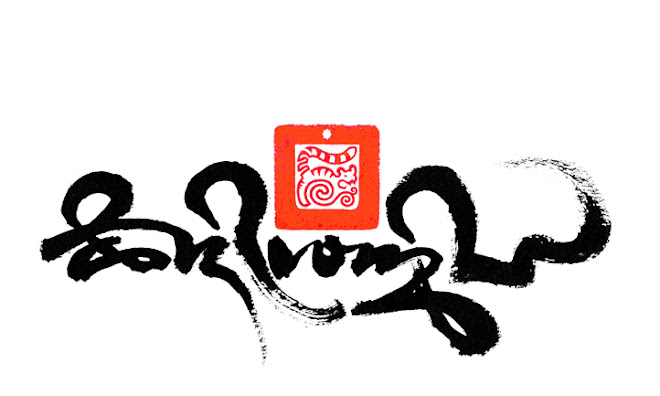For those who enjoy the art of beautiful letterform, be it inked on paper or incised in stone, of both East and Western traditions. You may enjoy to adventure out to contemplate art in a clear fresh gallery space or dwell in nature to enjoy the freedom of wondering between sculptures of wise words.....
From the 4th May to the 30th June 2013
Internationally celebrated Richard Kindersly and Tashi Mannox hold a joint exhibition at The Monnow Valley Arts Centre, majestically located beside the Black Mountains of the Brecon Beacon National Park.
From its purpose built art studio, galleries and beautifully arranged gardens, dotted with scriptural carved standing stones and other sculptural wonders, is a view that inspires greatness and lifts the heart.
Throughout the gardens Richard Kindersly exhibits his calligraphy sculptures called 'Material World'. In this exhibition Richard explores the difference between gestural and geomatrically constructed letter forms. These are skillfully demonstrated as carved letters in sandblasted glass, moulded concrete, wood, steel and paper (sometimes with the same text) to show us how lettering can be used in unusual ways and unusual materials.
While in the studio gallery Tashi Mannox exhibits a collection of works called 'Illuminated Optimism' from his Contemporary and traditional calligraphy series, depicting positive and thought provoking Tibetan Buddhist themes in a medium of ink on paper. Such as his first public showing of 'Hog eats Cock eats Snake' which represents the basic foundation of Samsara and the three aspects of ego: delusion, attachment and aversion, that feed on each other in a perpetual cycle. To remedy this on the path to liberation, Tashi illustrates the classical 'Four Foundations', four topics that are traditionally meditated upon, that lay a firm foundation of right motivation and diligence on the path to enlightenment.
The original Art pieces in the exhibition have been the basis for a series of high quality, limited edition Giclee prints that are also available for sale, making these works accessible to all.
A new embossed mantra art piece also premiers at the exhibition. This piece is the first of a new series of 'ink-less' calligraphy pieces which again demonstrates the diversity of Tashi's talent in bringing the integral tradition of Tibetan calligraphy into the 21st century.
Throughout the gardens Richard Kindersly exhibits his calligraphy sculptures called 'Material World'. In this exhibition Richard explores the difference between gestural and geomatrically constructed letter forms. These are skillfully demonstrated as carved letters in sandblasted glass, moulded concrete, wood, steel and paper (sometimes with the same text) to show us how lettering can be used in unusual ways and unusual materials.
While in the studio gallery Tashi Mannox exhibits a collection of works called 'Illuminated Optimism' from his Contemporary and traditional calligraphy series, depicting positive and thought provoking Tibetan Buddhist themes in a medium of ink on paper. Such as his first public showing of 'Hog eats Cock eats Snake' which represents the basic foundation of Samsara and the three aspects of ego: delusion, attachment and aversion, that feed on each other in a perpetual cycle. To remedy this on the path to liberation, Tashi illustrates the classical 'Four Foundations', four topics that are traditionally meditated upon, that lay a firm foundation of right motivation and diligence on the path to enlightenment.
The original Art pieces in the exhibition have been the basis for a series of high quality, limited edition Giclee prints that are also available for sale, making these works accessible to all.
A new embossed mantra art piece also premiers at the exhibition. This piece is the first of a new series of 'ink-less' calligraphy pieces which again demonstrates the diversity of Tashi's talent in bringing the integral tradition of Tibetan calligraphy into the 21st century.
The Immaculate Ushnisha mantra
om padmo ushnisha bi ma le hum phat
གཙུག་ཏོར་དྲི་མེད།
This is a purification mantra that is traditionally displayed on
a beam or above a doorway.
It is said that the mantra has the power to bless and cleanse
every-time one passes below, and is sometimes named as the ‘mind your head’
mantra.
The Monnow Valley Art centre is open to the public:
Wednesday - Friday 11am - 5pm
Weekends 2 - 5pm
Entrance to gallery exhibitions is free, but a donation is requested if not visiting the gardens.
Entrance to gardens, sculpture and National Collection of Contemporary Memorial Arts is by donation of £5 per adult (concessions £3) children under 14 for free.
The Monnow Valley Arts Centre see map
Walterstone
Herefordshire
HR2 0DY
01873 860 529









